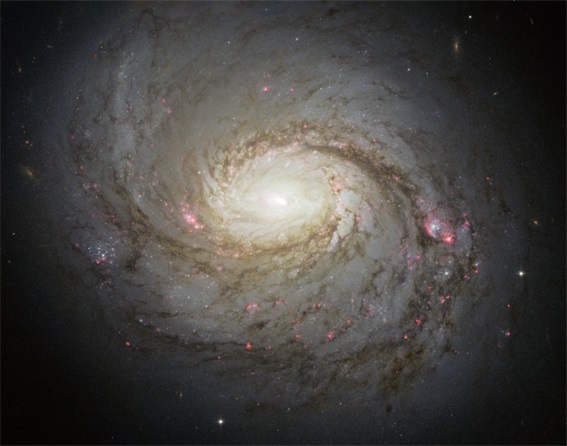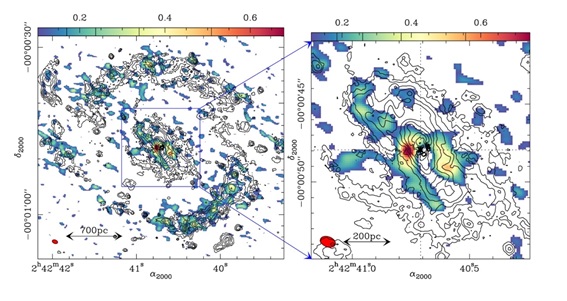Galaxias
El estudio del contenido, la distribución y la cinemática de la fase gaseosa del medio interestelar es clave a la hora de comprender cuáles son los mecanismos que dan lugar a la formación de nuevas estrellas y los que permiten el mantenimiento de la actividad nuclear en las galaxias. La espectacular fenomenología que describe las propiedades de las galaxias con actividad nuclear ('Active Galactic Nuclei': AGN) se interpreta como consecuencia de la alimentación de agujeros negros supermasivos que se encuentran en las núcleos de las galaxias. Los complejos procesos físicos involucrados en la alimentación de los agujeros negros supermasivos abarcan un amplio rango tanto de de energías como de escalas espaciales que necesitan un estudio detallado con la instrumentación astronómica adecuada. El análisis de cómo se produce el viaje del gas desde las escalas del disco de la galaxia hasta el agujero negro central, requiere el uso de trazadores específicos del gas interestelar neutro que sean sensibles al cambio de fase que se produce desde la fase atómica, dominante en la partes externas de las galaxias, hasta la fase molecular, que prevalece en las regiones más centrales.
Los interferómetros que operan en el rango de longitudes de onda milimétricas, como ALMA o NOEMA, son capaces de proporcionar en la actualidad imágenes extremadamente detalladas de la distribución y cinemática de la mayor parte del gas molecular en las regiones circumnucleares de las galaxias a partir de la observación de la emisión de las líneas rotacionales del monóxido de carbono (CO). Por otra parte, el estudio de cuáles son los efectos que tanto la formación estelar como la actividad nuclear tienen sobre la excitación, la química y la cinemática del gas, requiere el uso de trazadores más específicos sensibles a la fase más densa del gas molecular. Este tipo de observaciones realizadas con alta resolución espacial han permitido poner de manifiesto que existe una notable diferenciación en las propiedades químicas y en el estado dinámico del gas molecular en los diferentes entornos de la galaxias cercanas, debido a la huella que dejan en el medio interestelar tanto los brotes de formación estelar como la actividad nuclear (Figura. 1)
La formación de estrellas a partir del gas molecular interestelar es un agente fundamental de evolución galáctica. La Astrofísica actual se esfuerza en comprender los diferentes aspectos de este complejo proceso, el cual involucra mecanismos físicos que actúan en un amplio rango de escalas espaciales. Observando galaxias muy lejanas con interferómetros de ondas milimétricas como IRAM NOEMA y ALMA, se investiga cómo el gas molecular moldeó la época más activa de formación estelar en el Universo, hace unos diez mil millones de años. Estas observaciones permiten evaluar el balance entre la caída y la expulsión de gas en diversas poblaciones de galaxias, así como los efectos de realimentación causados por los agujeros negros supermasivos y la formación estelar. En la actualidad, tales efectos son un elemento imprescindible de los modelos cosmológicos de formación de galaxias. Al escudriñar en detalle galaxias más cercanas, los radiotelescopios milimétricos también ayudan a entender cómo las galaxias han autorregulado su crecimiento a lo largo de su evolución. En particular, las observaciones de líneas espectrales moleculares informan la mayoría de los modelos teóricos de formación estelar. Dichas observaciones muestran cómo el entorno de las nubes moleculares condiciona sus propiedades físicas y, en última instancia, su capacidad de formar estrellas.



